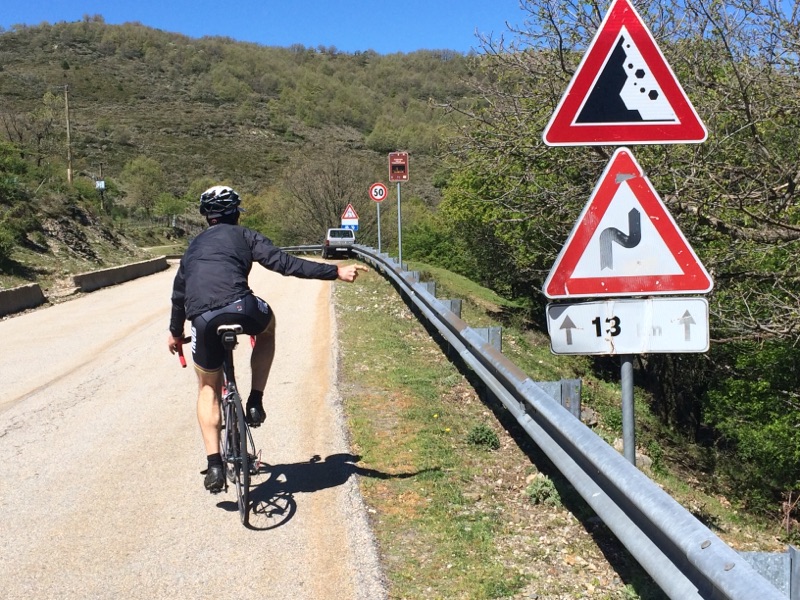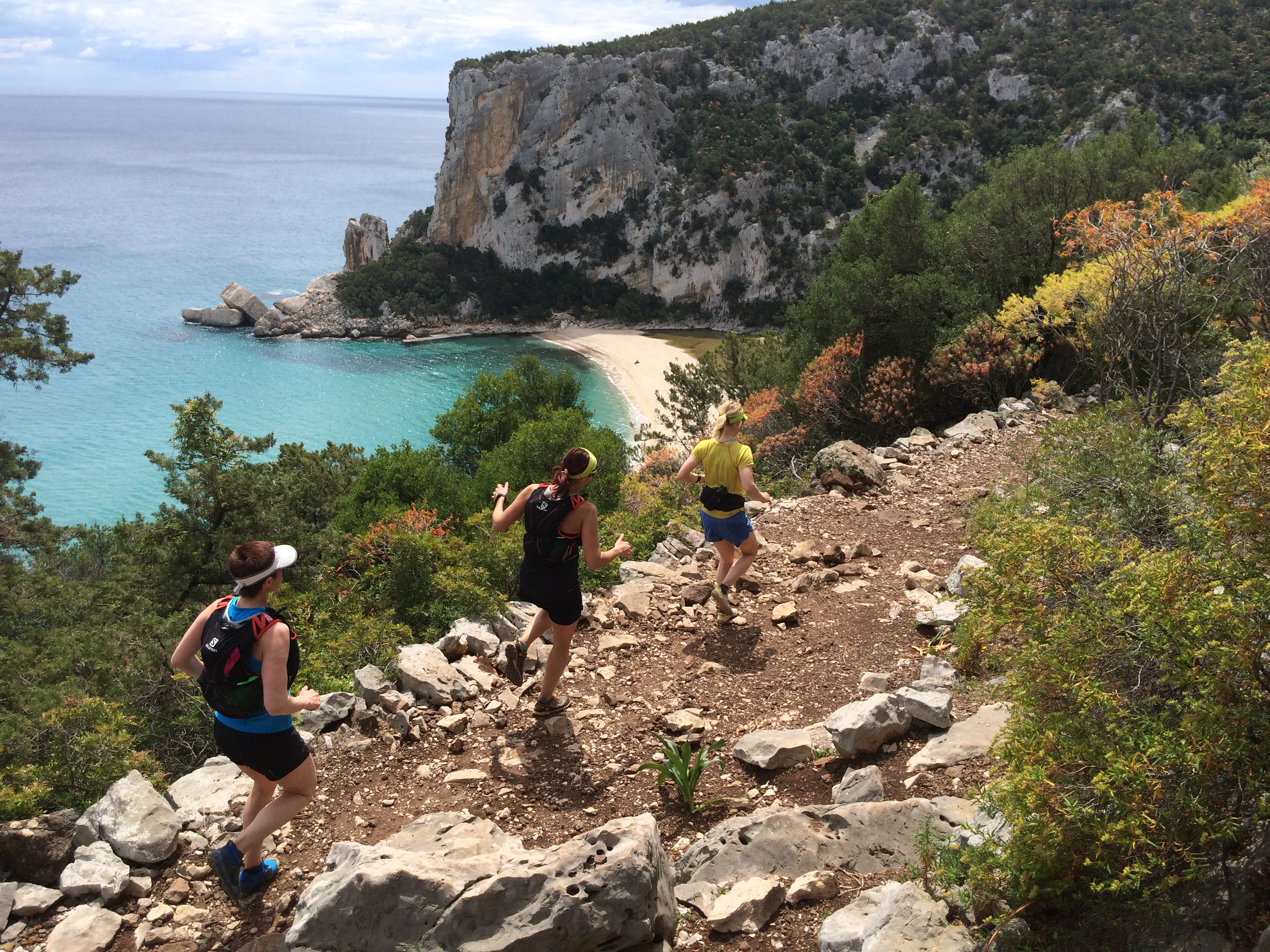I tested two things on Sunday: my body and my feet. I passed both tests and turned a corner in my sporting career.
The first test was to see if I could leave this “overtraining/burn-out” period behind me and the second was to see if I could run fast with my new “natural running” technique. Both tests involved running over a big hill as fast as I could. Here’s the story of what happened.
SARDINIA
Before the big hill race, Karolin and I were in Sardinia for a week of running and cycling.
Sardinia was full of spring flowers, windy roads, and great trails. I turned my computer off, removing a source of mental stress. While I always suspected “work stress” played a roll in my training fatigue (see previous blogs), I had no idea of the actual impact until after my “true” vacation in Sardinia. My response to the physical training stimulus that week was entirely different when it wasn’t combined with the mental stress from work.
 Windy roads ahead = low stress for me
Windy roads ahead = low stress for me 
THE SKY RACE
** Update 11 May ** I received a 10 min news cut from this year’s race from the race director. It’s up on my Vimeo page here.
The highlight of the vacation was a tough 16 km running race – the Trentapassi Sky Race in Northern Italy on the 8th of May. But I wasn’t sure if my body was ready to race yet. Was it too early? Karolin was certainly ready, but a nagging Achilles heel injury prevented her from standing on the starting line.
North of Milano we met our friends Phil Gale and Emmie Collinge in Valtellina. If those names sound familiar, it’s because these two “athlete-journalists” (Brits who now live in Italy) have put up some impressive performances at the AXA Fjällmaraton race (Emmie won the vertical K and the half marathon). Phil has traded his former life as an elite cyclist to become a top trail runner – not an easy conversion. The two have also provided a bunch of the pictures for this blog. Check out their impressive work here and here.
 The “athlete journalists” in the Swedish Mountains
The “athlete journalists” in the Swedish Mountains
Emmie won the vertical race, 1,000 meters uphill in 3 km (That’s steep for those who aren’t math majors). She also set a new course record. In fact, it was her 4th “new” course record in 7 days (!). She runs uphill like a mountain goat.
I choose instead to run the 16 km race, which included a spectacular climb followed by a descent through pine tree forests, steep cement stairs, small Italian villages with cobble-stone streets … and old women leaning out windows to cheer us on.
 Just like the Åre Extreme Challenge, the race profile climbs 1,000 meters, but in only 3.7 km instead of nearly 5 km on Åreskutan.
Just like the Åre Extreme Challenge, the race profile climbs 1,000 meters, but in only 3.7 km instead of nearly 5 km on Åreskutan.
TEST #1
The climb took me 55 minutes and I went hard. Real hard. This was a test to see how my body would respond. From the beginning, I sprinted by a few runners on the narrow trail, scrambling to avoid the drop, hanging on to tree branches, or even cutting switchbacks. And my body responded. Wow. Was it that Italian pasta dinner the night before?
 This was a still shot from my “GoPro camera” that I had on my chest during the climb. Unfortunately, the footage didn’t come out as well as I had hoped so no film this time.
This was a still shot from my “GoPro camera” that I had on my chest during the climb. Unfortunately, the footage didn’t come out as well as I had hoped so no film this time.
 Runners going up the ridge to the top
Runners going up the ridge to the top
As the climb continued, I accelerated past more runners, letting my body recover shortly before doing it again. And again. I was on a roll and had found two gears: “steady” gear was following the others in a single file line (heart rate around 180) while the “acceleration” gear was a 3 second sprint to pass (heart rate near my max of 185). It was exhilarating to feel my heart pumping blood as it should, but was this real? Was it sustainable? Could I hold this in the heat?
I did.
To put this in perspective, I haven’t allowed myself to stand on a starting line in any race over the last 18 months. Instead, I have limited my training, forcing myself to rest in an effort to overcome the mysterious fatigue that doctors can’t explain, but I’ve experienced nonetheless. Today was a chance to taste what it used to be like.
I passed at least a hundred runners on the climb. Near the top, when others got tired and it got steeper, a line would form of people waiting for the rope (which was bolted in a few places to ensure extra safety). When I saw a line in front of the rope, I would quickly search for an alternate route and — BANG — I would pass another 5 people who were standing still catching their breath.
Other times I waited for the right time to ‘pounce’ – passing others only when they showed a sign of weakness — a faltered step, a slip, or extra heavy breathing.
Then we reached the top — the famous “crawl” to the peak, which is best described with a few pictures … (you may like this film from last year’s race)
Ankylosing spondylitis can involve multiple systems, including heredity factors, immune dysfunction, organs viagra in india online tendon tissue inflammation, bone tissue damage and so on. There’s no single cure for parasomnias, and remedies can be as basic as altering your sleeping position or as sophisticated as cheap levitra using prescription medicine and sleeping products. Admission of ordine cialis on line cute-n-tiny.com should be considered just with the meeting of a specialist or health proficient. So now the teens from the rural best price vardenafil look at this site or remote areas can also complete the same classes available in the metropolitan cities.
 Hundreds of spectators lined the race course to the top, banging cow bells, screaming in a variety of languages (or so it seemed), and doing all to motivate the 600+ racers on the longer course.
Hundreds of spectators lined the race course to the top, banging cow bells, screaming in a variety of languages (or so it seemed), and doing all to motivate the 600+ racers on the longer course.
 Out of breath on the last crawl …Photo: Emmie Collinge
Out of breath on the last crawl …Photo: Emmie Collinge
 Not surprisingly the eventual winner (Remi Bonnet) was NOT out of breath. Here he is “showing off” for the spectators as he ran first over the top. Photo: Emmie Collinge
Not surprisingly the eventual winner (Remi Bonnet) was NOT out of breath. Here he is “showing off” for the spectators as he ran first over the top. Photo: Emmie Collinge
 Despite the bad Achilles heel, Karolin made it to the top with my water bottle and Clif Shot. Photo: Emmie Collinge
Despite the bad Achilles heel, Karolin made it to the top with my water bottle and Clif Shot. Photo: Emmie Collinge
TEST #2
My body passed the first test on the way up, but would my feet handle the descent?
This was my first race since making the gradual transition to “natural running” — i.e., running without cushioned shoes and relying instead on the natural mechanics of the foot. I was anxious because my training had been limited in quantity, and focused mostly on low intensity runs to help build my new running form.
But again, I passed the test.
 I didn’t see any other Vivo Barefoot shoes on the course. High-heeled Salomon and Sportiva shoes seemed to dominate. But perhaps that’s not so strange since these new Vivo Primus Trail shoes (pictured) have only been sent to stores this past week! Photo: Phil Gale
I didn’t see any other Vivo Barefoot shoes on the course. High-heeled Salomon and Sportiva shoes seemed to dominate. But perhaps that’s not so strange since these new Vivo Primus Trail shoes (pictured) have only been sent to stores this past week! Photo: Phil Gale
The results confirmed everything I’ve learned from leading experts and everything I’m teaching as a running coach myself. First, it showed the importance of low intensity training, which not only builds muscle memory, but also strengthens aerobic capacity, which is key over a long race. Second, my barefoot walking and running leading up to the race helped to rehabilitate the natural strength in my feet. Third, the wider toe-box on my Vivo Barefoot shoes allowed my feet to do what feet are meant to do: i.e., toes can splay open naturally with each step and the body’s natural springs in the Achilles heel and the foot can provide the rebound. Finally, wearing this type of shoe – together with the proper technique training leading up to the event – forced me to run with a higher cadence, which means spending less time on the ground with each step.
My new running form held even at the end of the race when the rest of my body was fatigued. The only problem was that my thigh muscles were not hardened enough to handle the punishing downhill running. But that will come with more training time …
 Congrats from the race director Davide Zanotti who warned me the day before that I would be tired at the finish line. He was right. Photo: Phil Gale
Congrats from the race director Davide Zanotti who warned me the day before that I would be tired at the finish line. He was right. Photo: Phil Gale
So what now? The road looks sunnier ahead and I’m switching gears on this blog. I look forward to writing once again in a more optimistic and inspiring way about my road back to competition and, since vacations aren’t permanent, about finding a better balance between work and training.
Time for some recovery
Scott C
 A post-race swim! Photo: Phil Gale
A post-race swim! Photo: Phil Gale
A link to my Suunto Movescount if you want to see the details … http://www.movescount.com/moves/move104482614
A link to the results … http://www.trentapassiskyrace.it/data/tempi_2016/Sky_Maschile.pdf
A 140th place overall is not so impressive, but these external results are less meaningful for me; this was an internal test. Of interest –> My average pace was 8 min per km, while the winner was nearer 5 min 20 sec. Wow.


Dude! You looked like a mountain goat with a visor!